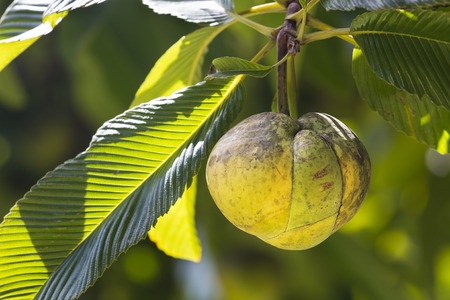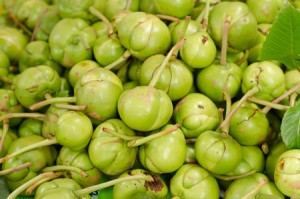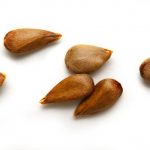
The Elephant Apple (Dillenia indica Linn.) is a peculiar fruit which is rarely seen in the West. It is a member of the Dillenia family which are evergreen shrubs, widely distributed throughout India, Indonesia, Taiwan, Japan, Thailand, China, and South-East Asia generally. The fruit is also known as chalta or chulta in the far East.
The trees are about 30 to 50 ft. in height, bearing large and rather hard fruit of between 3 to 5 inches in diameter. The fruit consists of five closely fitted imbricate sepals enclosing numerous seeds embedded in a gelatinous pulp. The tree flowers during May to August and the fruits ripen during September to early March. The ripe fruits are gathered while the sepals thicken.
The unripe fruit is acidic and astringent and generally unusable (Shome et al., 1980; Yazan and Armania, 2014).The ripe fruit is described as having both sweet and sour flavours and to be highly nutritious. It is commonly eaten fresh and cooked, and readily prepared as confectionary, jams, jellies and in desserts.
Uses
Traditionally, the fruits, leaves, and barks of D. indica are used to treat various diseases such as fevers, stomach complaints and pains, constipation or diarrhea amongst other conditions associated with the digestive tract (Yazan and Armania, 2014).

A decoction of fruit has been assessed for treating hair loss and diabetes, and may also be an immunity enhancer (Gandhi and Mehta, 2014; Yazan and Armania, 2014). The juice of an elephant apple mixed with sugar and water can function as an expectorant – a cough syrup with cooling effects (Yazan and Armania, 2014).
Fruits and leaves of the plant possess anti-oxidant and anti-inflammatory properties. A number of important bioactive compounds, such as the triterpenes (Banerji et al., 1975), phenols (Das et al., 2012), and lupeol, betulinaldehyde, betulinic acid, and stigmasterol (Parvin et al., 2009; Kumar et al., 2010) were found in D. indica species.
Extracts of phytochemicals from D. indica possess several biological activities such as being an antioxidant, an anti-inflammatory, antidiabetic, anti-cholinesterase, antimicrobial, and cytotoxic activities (Abdille et al., 2005; Kumar et al., 2010; 2011; Migliato et al., 2011; Bhadra et al., 2014).
Different extracts of D. indica fruits showed different antileukaemic activity against human leukaemia cell lines with the ethyl acetate extracts producing the highest cytotoxic activities (Kumar et al., 2010). Solvent extracts using ethyl acetate, methanol, and water from the fruits also produced various antioxidant activities (Abdille et al., 2005). The water extracts of the fruits can be used as a natural muco-adhesive agent for formulation of gels (Kuotsu et al., 2007). Glycolic extracts of mature fruits possessed a significant wound-healing activity of the skin when combined with micro-current processes (Migliato et al., 2011). In a methanolic extract, the total phenolic content was about 34% (w/w) (Abdille et al., 2005).
Chromane extracted from its leaves is claimed to improve the neuronal dysfunction in STZ-induced diabetic neuropathy (Kaur et al., 2017).
The proanthocyanidins in this species of elephant apple have been reported. Using both FRAP and ORAC methods for measuring antioxidant potential, the researchers from Singapore were able to identify various proanthocyanidins (EAPs) which had higher ORAC and FRAP values than various commercial grape seed types (Fu et al., 2015).
References
Abdille, M.H., Singh, R.P., Jayaprakasha, G.K., Jena, B.S. (2005). Antioxidant activity of the extracts from Dillenia indica fruits. Food Chem. 90 pp. 891–6.
Banerji, N., Majumder, P., Dutta, N.C. (1975). A new pentacyclictriterpenes lactone from Dillenia indica. Phytochemistry 14 pp. 1447–8.
Bhadra, S., Dalai, M.K., Chanda, J., Kar, A., Mukherjee, P.K. (2014). Screening of anticholinesterase activity of the standardized extract of Dillenia indica fruits. Eur. J. Integr. Med. 6(6) pp. 738.
Das, M., Sharma, B.P., Ahmed, G., Nirmala, C.B., Choudhury, M.K. (2012). In vitro antioxidant activity and total phenolic content of Dillenia indica and Garciniapenducalata, commonly used fruits in Assamese cuisine. Free Radic. Antioxid. 2 pp. 30–6.
Fu, C., Yang, D., Pei, W.Y.E., Lai, S., Feng, X., Y. H. (2015) Structure and Antioxidant Activities of Proanthocyanidins from Elephant Apple (Dillenia indica Linn.). J. Food Sci. 80 (10) C2191-2199
Gandhi, D., Mehta, P. (2014). Dillenia indica Linn.and Dillenia pentagyna Roxb.: pharmacognostic, phytochemical and therapeutic aspects. J. Appl. Pharm. Sci. 3 pp. 134–42
Kaur, N., Kishore, L. Singh, R. (2017) Chromane isolated from leaves of Dillenia indica improves the neuronal dysfunction in STZ-induced diabetic neuropathy. J. Ethnopharmacology. 206 pp. 19-30
Kumar, D., Mallick, S., Vedasiromoni, J.R., Pal, B.C. (2010). Anti-leukemic activity of Dillenia indicaL. fruit extract and quantification of betulinic acid by HPLC. Phytomedicine 17 pp. 431–5.
Kumar, S., Kumar, V., Prakash, O. (2011) Antidiabetic, hypolipidemic and histopathological analysis of Dillenia indica (L.) leaves extract on alloxan induced diabetic rats. Asian Pac. J. Trop. Med. 4(5) pp. 347–52.
Kuotsu, K., Bandyopadhyay, A.K. (2007). Development of oxytocin nasal gel using natural mucoadhesive agent obtained from the fruits of Dellinia indica L. Science Asia 33 pp. 57–60.
Migliato, K.F., Chiosini, M.A., Mendonca, F.A., Esquisatto, M.A., Salgado, H.R.N., Santos, G.M. (2011). Effect of glycolic extract of Dillenia indica L. combined with microcurrent stimulation on experimental lesions in Wistar rats. Wounds 23 pp. 111–20.
Parvin, M.N., Rahman, M.S., Islam, M.S., Rashid, M.A. (2009). Chemical and biological investigations of Dillenia indica Linn. Bangl. J. Pharmacol. 4 pp. 122–5.
Shome, U., Khanna, R.K., Sharma, H.P. (1980) Pharmacognostic studies on Dillenia indica Linn. II-Fruit and seed. Proc. Indian Acad. Sci. Plant Sci. 89 pp. 91–104.
Yazan, L.S., Armania, N. (2014) Dillenia species: A review of the traditional uses, active constituents and pharmacological properties from pre-clinical studies. Pharm. Biol. 52 pp. 890–7.


Leave a Reply